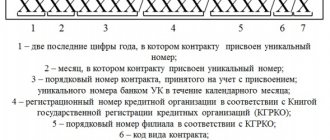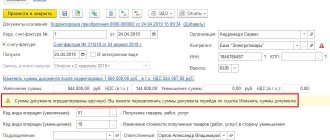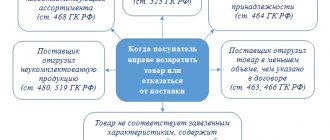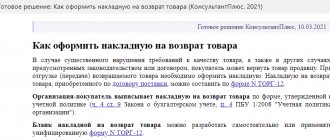What is a personal matter
An employee’s personal file is a package of documents and information about the employee regarding the positions he holds and work at the enterprise. This set of documents is prepared for each employee of the organization.
According to the Federal Law of April 27, 2004 No. 79-FZ and the Decree of the President of the Russian Federation of May 30, 2005 No. 609, maintaining personal files is mandatory for civil servants, for other categories - at the request of the employer.
In practice, every enterprise keeps records of personal files, which helps to systematize the work of the personnel department and the organization. The storage period for the personal files of dismissed employees is 50 years.
The legislative framework
- Federal Law dated April 27, 2004 No. 79-FZ
- Decree of the President of the Russian Federation of May 30, 2005 No. 609
- subp. “c” clause 6, part 1, art. 81 Labor Code of the Russian Federation
- Art. 192 Labor Code of the Russian Federation;
- clause 7, part 1, art. 243 Labor Code of the Russian Federation;
- Art. 13.11 Code of Administrative Offenses of the Russian Federation;
- 14 Code of Administrative Offenses of the Russian Federation;
- Art. 137 of the Criminal Code of the Russian Federation;
- 140 of the Criminal Code of the Russian Federation;
- Order of the Ministry of Culture dated August 25, 2010 No. 558;
- “List of standard management archival documents generated in the process of activities of government agencies, local governments and organizations, indicating storage periods” (Order of the Ministry of Culture dated August 25, 2010 No. 558).
How, in light of the latest changes in the law on archiving, how to determine the storage period for personal files?
1. Personnel documents
(except for documents specified in part 3 of this article)
created before 2003
are stored:
1) in state bodies, local government bodies and organizations that act as sources of acquisition of state and municipal archives with archival documents - within 75 years from the date of creation with an examination of the value of the documents after the expiration of the specified storage period;
2) in state and municipal archives, which receive documents on the personnel of liquidated state bodies, local government bodies, state, municipal and non-state organizations - from the date of receipt until the expiration of 75 years from the date of creation with an examination of the value of the documents after the expiration of the specified shelf life;
3) in other organizations - at least 75 years from the date of creation.
2. Personnel documents
(except for documents specified in part 3 of this article)
created starting from 2003
are stored:
1) in state bodies, local government bodies and organizations that act as sources of acquisition of state and municipal archives with archival documents - within 50 years from the date of creation, with an examination of the value of the documents after the expiration of the specified storage period;
2) in state and municipal archives, which receive documents on the personnel of liquidated state bodies, local government bodies, state, municipal and non-governmental organizations - from the date of receipt until the expiration of 50 years from the date of creation with an examination of the value of the documents after the expiration of the specified shelf life;
3) in other organizations - at least 50 years from the date of creation.
3. Documents on personnel generated in connection with the passage by citizens of public service that is not the state civil service are stored:
1) in state bodies in which citizens served in public service that is not the state civil service - for 75 years after the termination of public service with an examination of the value of documents after the expiration of the specified storage period;
2) in state archives that receive documents on the personnel of liquidated state bodies specified in paragraph 1 of this part - from the date of receipt until the expiration of 75 years from the date of termination of public service with an examination of the value of the documents after the expiration of the specified storage period.
How an employee’s personal file is formed
The personal file of a dismissed employee is formed according to the dossier principle and is stored in the personnel department of the organization until the end of the calendar year. Within 3 years after dismissal, documents undergo archival and technical processing and are transferred to the archive.
After archiving, there are some aspects that need to be completed:
- The case needs to be stitched or bound.
- Remove all paper clips and staples, stitch 4 protocols into a hard cover.
- Personal documents are placed in an envelope filed in the file and numbered as a sheet. Each investment is numbered in turn (military ID, work record book, diploma, identity card, etc.).
- At the end of the case, it is necessary to file a blank sheet and draw up a document certifying the case, which is not included in the total number of sheets of the folder.
Documents inside the folder should be arranged chronologically - from the first documents to the last. Thus, the earliest document comes first, for example, consent to data processing, and the last is the order to dismiss the employee.
This is also important to know:
Dismissal of a pregnant woman under a fixed-term employment contract: important nuances
According to Decree of the President of the Russian Federation dated May 30, 2005 No. 609, the enterprise implements a mandatory procedure for collecting data on employees. These include the following documents:
- Application form, resume, characteristics and personnel records sheet.
- Copies of passport, educational documents (diplomas, certificates), TIN, insurance certificate, documents on marital status.
- Information from certification.
- Labor contract.
- Employer orders (on appointment, transfer to another position or place of work, vacations and business trips).
Personal file of a dismissed employee, sample internal inventory
Sample of a personal file certification sheet
Composition of an employee's personal file
The personal file consists of two sections:
- Biographical and characterizing documents.
- Additional documents.
The first group of documents includes:
- addition to the personal personnel record sheet;
- a personal personnel record sheet with a pasted photograph or a questionnaire;
- autobiography;
- copies of education documents (certified by the signature of an employee of the personnel department and a seal after presentation of the original document);
- personal application for employment or dismissal;
- extracts from orders for hiring or dismissal (copies of such orders);
- employment contract;
- job description;
- employee applications for transfers;
- submissions for transfers, promotion, enrollment in the reserve;
- extracts from movement orders (copies of such orders);
- certification sheets;
- characteristics and letters of recommendation;
- reviews of officials about the employee;
- extracts (copies) from documents on the conferment of honorary titles, academic degrees, and state awards;
- copies of award sheets.
The second group of documents includes:
- old certification sheets, personnel certificates, questionnaires;
- cards for recording rewards and penalties;
- characteristics from previous place of work;
- health certificates;
- photos;
- other documents that should be kept in your personal file.
An internal inventory is compiled for each section of the personal file. It records the names of all filed documents, the date the document was included in the personal file, the number of sheets, the date the document was seized, by whom it was seized and for what reason. The personnel employee who draws up the inventory must sign it and date it. .
You can remove any document from your personal file only with the permission of the head of the personnel department or the head of the company. In this case, you need to make a note about this in the “Note” column of the internal inventory.
In place of the temporarily seized document, a substitute certificate is inserted, which must indicate the date, the reason for the seizure, the signature of the employee who issued the document and the one who received it for temporary use.
Attention
Examples of filling out personnel documents can be found in the online berator “Personnel. Remuneration" or in the printed version of the berator - "Employees and You".
Each file includes a photograph of the employee, on the back of which his last name, first name, patronymic, signature of the head of the personnel department and the company seal must be indicated. It is also advisable to set the date of photographing.
What documents are included in a personal file?
The composition of personal files, as well as the procedure for formation, for private entrepreneurship is not fixed at the legislative level, but it must be properly prescribed in the local act of the company.
Documents that usually belong to a personal file can be divided into several groups:
- Primary documentation for hiring. This includes those documents that employees provide upon employment, and those that are filled out and entered directly during registration. It can be:
- summary;
- documents on education and qualifications;
- copies of identification documents (passport, SNILS, identification code, if any);
- recommendations or reviews from previous employers (if necessary);
- a document or a copy thereof regarding military registration (if available);
- certificate of no criminal record (needed when applying for certain positions);
- medical examination data;
- completed application form (if provided);
- employment application;
- a copy of the admission order;
- concluded employment contract, etc.
- Papers that appeared in the process of working in this position. They may reflect the employee's professional achievements or his social dynamics. These may include:
- various qualification certificates;
- driver license;
- marriage or divorce certificate, if these events occurred during employment;
- birth certificates of children (same justification);
- job description;
- additional agreements concluded (if this was done);
- a copy of the agreement on financial responsibility (if the position provides for it);
- certification certificates;
- data from regular medical examinations;
- documents establishing medical restrictions or disability (if this happened during work);
- copies of orders about internal changes in position (transfer, promotion, demotion, etc.);
- data on disciplinary sanctions and work incentives;
- leave requests;
- reports, explanatory notes, memos, etc.
- Documents confirming the employment relationship with this employer. Before the case is dismissed, it must be properly completed. The latest documents in the personal file folder may be:
- resignation letter;
- a copy of the dismissal order;
- documents on dismissal due to external transfer;
- employee's death certificate.
What is the retention period for documents that are not part of personal files?
Yu.I. Udalova, author of the answer, legal consultant to Askon
QUESTION
How long should the following documents be kept:
- employees’ consent to work overtime, work on days off,
- applications for admission and dismissal, transfer.
ANSWER
- In our opinion, the retention period for employee consent to work overtime and work on days off depends on the content of the relevant orders. If the orders do not specify the clause on payment for such work (a separate order on payment is issued), then the retention period for the consent of the employees will be 5 years, if the orders mention the payment of employees - 75 years.
- The storage period for employee applications for hiring, dismissal, and transfers that are not part of personal files is 5 years.
JUSTIFICATION
1.
Relations in the field of organizing storage, acquisition, accounting and use of documents, regardless of their form of ownership, are regulated by Federal Law No. 125-FZ of October 22, 2004 “On Archival Affairs in the Russian Federation” (hereinafter referred to as Law No. 125-FZ). The obligation to maintain and ensure the safety of relevant personnel documentation is established in Part 1 of Art. 17 of Law No. 125-FZ.
Based on Part 3 of Art. 6 of Law N 125-FZ approved the List of standard management archival documents generated in the process of activities of state bodies, local governments and organizations, indicating storage periods (Order of the Ministry of Culture of Russia dated August 25, 2010 N 558) (hereinafter referred to as the List).
The storage period for orders on engagement to work on weekends and holidays, and on engagement in overtime work will be 5 years, unless such orders contain a clause on payment for such work, that is, a separate order is issued on payment to employees engaged to work on weekends ( holidays, and overtime. If orders for hiring workers on weekends and holidays, or for engaging in overtime work mention the payment of workers, then such orders must be kept for 75 years (clause “b” of Article 19 of the List).
In our opinion, the storage period for documents related to these orders, including written consents of employees to be involved in work on weekends or overtime, depends on the storage period for the relevant orders. If the orders do not specify the clause on payment for such work (a separate order on payment is issued), then the retention period for the consent of the employees will be 5 years, if the orders mention the payment of employees - 75 years.
2.
Documents (certificates, reports, memos, copies of orders, extracts from orders, statements, etc.) that are not included in personal files are stored for 5 years (Article 665 of the List).
| 19 | Orders, instructions; documents (certificates, summaries, information, reports) to them: | (1) Sent for information - until the need has passed |
| a) on the main (core) activity | Fast. <**> (1) | (2) On disciplinary sanctions, annual paid vacations, vacations in connection with training, duty, short-term domestic and foreign business trips - 5 l. |
| b) on personnel (reception, transfer, combination, transfer, dismissal; certification, advanced training, assignment of titles (ranks); change of surname; promotions, awards; wages, bonuses, various payments; all types of leaves for workers with heavy, harmful and hazardous working conditions, maternity leave, leave without pay (salary); duty in the core activity; long domestic and foreign business trips, business trips for workers with difficult, harmful and hazardous working conditions) | 75 l. (2) EPC | |
| c) on administrative and economic issues | 5 l. |
Extract: Order of the Ministry of Culture of Russia dated 08/25/2010 N 558 (as amended on 02/16/2016) “On approval of the “List of standard management archival documents generated in the course of the activities of state bodies, local governments and organizations, indicating storage periods” {ConsultantPlus}
| 665 | Documents (certificates, reports, memos, copies of orders, extracts from orders, statements, etc.) not included in personal files | 5 l. |
Who do they file personal files against?
This question can be answered unequivocally only in relation to civil servants: for all, as required by law.
Since maintaining personal files is not necessary for private entrepreneurs, they themselves can decide which employees to keep this documentation for, and which ones can do without such detailed personnel records. Some managers who practice this system prefer to keep personal records for all personnel in order to systematize data for each employee. But some, in order to save time, organize the management of personal files only for certain categories of employees.
This is also important to know:
Enterprise Management
Personal files are usually opened for employees of what positions:
- management;
- deputy managers at various levels;
- key specialists;
- employees bearing financial responsibility;
- personnel reserve, etc.
FOR YOUR INFORMATION! It is advisable to open a personal file for such employees, regardless of the form and time of his employment - he works part-time or at his main job, under a fixed-term employment contract or on a permanent basis.
Less often, positions are provided with personal records for which educational, qualification or other special requirements are not provided, for example, cleaner, watchman, janitor, etc.
Procedure for conducting personal affairs
A personal file (PD) is a set of documents relating to one employee and containing information about his labor (official) activities and length of service.
In budgetary organizations, as a rule, records are maintained for all employees. However, it is possible to conduct them selectively, for example, only for management personnel, financially responsible persons, etc. By maintaining we mean:
- timely entry of records of all changes: personal and biographical information, job position, etc.;
- inclusion of incoming materials and their withdrawal;
- issuance of case materials, certification of copies;
- maintaining an internal inventory;
- periodic checking of the state of affairs;
- closing and preparation for transfer to the archive, etc.
- The procedure for maintaining and the list of documents attached to the LD is approved by local regulations.
Responsibility for personal affairs
The list of employees who have access to personal files is regulated by order of the head of the organization. The employee also has the right to familiarize himself with any information regarding his person, which is kept by the personnel officer.
Access of third parties to personal information is prohibited and is classified as a violation of the legislation of the Russian Federation.
Free legal consultation
We will answer your question in 5 minutes!
Free legal consultation We will answer your question in 5 minutes!
Ask a Question
Ask a Question
According to the current legislation of the Russian Federation, those responsible for violating the inviolability of personal data can be held accountable:
- disciplinary (subparagraph “c”, paragraph 6, part 1, article 81 and article 192 of the Labor Code of the Russian Federation);
- material (clause 7, part 1, article 243 of the Labor Code of the Russian Federation);
- administrative (Articles 13.11 and 13.14 of the Administrative Code of the Russian Federation);
- criminal (Articles 137 and 140 of the Criminal Code of the Russian Federation).
According to Part 2 of Art. 13.11 of the Code of Administrative Offenses of the Russian Federation, working with personal data without written consent entails a fine of 3,000–5,000 rubles. (for citizens) up to 15,000–75,000 rub. (for legal entities).
Responsibility for dissemination of personal data
When working with PD, you must remember that this is simultaneously working with PD, which, in turn, relates to confidential information and has restrictions on its collection, processing, storage and distribution.
For violation of the provisions of the legislation on the protection of personal data, disciplinary, material, civil, administrative and criminal liability is provided (Article 90 of the Labor Code of the Russian Federation, Federal Law No. 152 of July 27, 2006).
In addition, as of July 1, 2017, changes to the Code of Administrative Offenses of the Russian Federation came into force (Federal Law No. 13 dated February 7, 2017), which mainly affected Art. 13.11. This Federal Law expanded the list of grounds on which an employer can be held accountable and increased the amount of fines for violations in the field of ensuring personal data protection.
The procedure for creating an employee’s personal file after dismissal
The personal file is closed on the day the person is fired. After this, the authorized specialist must complete it in full:
- check the presence of all documents;
- check the chronology of papers in the folder;
- check the numbering of sheets (all sheets are numbered in Arabic numerals with gross numbering in the upper right corner of the sheet with a simple pencil or numberer).
Then you need to make a final entry on the internal inventory. It indicates the number of sheets included in the LD, as well as the number of sheets of the inventory itself (its sheets should be numbered separately). After which the compiler must sign both the inventory and the final entry. After which you can draw up a so-called certification sheet, which will contain a description of your personal file. Next, all the papers are stitched together: at the beginning of the folder there is an inventory, and at the end there is a certification sheet. On the title page you need to write the closing date in accordance with the dismissal order, as well as the retention period of the entire folder.
Please note that if the dismissed person did not take any original documents, for example, a military ID or medical record, they must be kept until required in his LD. To do this, they should be placed in envelopes (each document separately) and filed in a folder. Such envelopes are numbered, sealed and certified by the signature of an authorized person.
After dismissal of an employee, we transfer documents to the archive
On the day of dismissal, the employee signs not only the work book, but also his own personal card. After this, the document will not return to its original place, but will be placed in the “Personal cards of dismissed employees” group. These cards are stored in the same way in a locked cabinet, but separately from others, so that over time they can be transferred to the organization’s archive.
If the company practices managing personal affairs, then after closing the personal file, the personal file is closed: a copy of the order to terminate (terminate) the employment contract and an original copy of the resignation letter or other document (or a copy thereof) that served as the basis for terminating the employment relationship is placed in it. Then the personal files will also be sent to a special group “Personal files of dismissed employees”, where they will await transfer to the archive.
Personal files and personal cards are taken into account according to the year of dismissal of employees.
The personal card of employee Petrov, who resigned in 2021, will be placed in the file for 2021, despite the fact that Petrov started working in 2010. And the personal card of Ivanov, who was hired in the same 2010 and left in 2021, will be included in a similar file for 2021. Even if the personal cards of Ivanov and Petrov were simultaneously handed over to the organization’s archive, they will be stored separately from each other, each in a volume for “its own” year, in addition, they will fall into different annual sections of the inventory of personnel affairs.
When dismissing an employee, the date and number of the dismissal order are indicated in the Registration Journal (and the Alphabet Book, if one is maintained). Let's explain why this is done. When a personal file is requested from the archive, as a rule, the personnel officer informs the archivist of the year the employee was dismissed. Based on these data, it is easier to search for a personal file in the archive, especially if the organization has a large staff.
In practice, we came across an organization that had about 10,000 personal files of dismissed employees. But there was another problem: often fired employees returned and got jobs again. Then the personnel officers took the file of such a person from the archive and continued to conduct it. Some workers had 3-4 volumes combined into 1 file. But this is not a typical situation.
So, the archivist looks at the inventory of personnel files for the year of dismissal named by the personnel officer and finds the file. The archivist searches for a personal file by its numbers: according to the inventory of files by personnel and the archive number (this is a serial number within the inventory).
Employees who joined at the same time will leave at different times. The personal files of dismissed employees will be included in the inventory according to the year of dismissal. On the cover of the personal file (if it is created separately, not in the work order), it will be necessary to indicate the beginning and end of work in the organization - the date of the hiring order and the date of the dismissal order. The archival stamp indicates the case number in accordance with the serial number of the case in the inventory.
According to clause 4.1 of the Rules for organizing the storage, acquisition, recording and use of documents from the Archive Fund of the Russian Federation and other archival documents in government bodies, local governments and organizations (approved by order of the Ministry of Culture of Russia dated March 31, 2015 No. 526), structural units must transfer documents for personnel “to the organization’s archive no earlier than 1 year and no later than 3 years after the completion of office work.”
Of course, it is desirable that all structural units transfer completed paperwork documents in a timely manner - annually and according to an agreed schedule. This is especially true for documents of permanent storage and for personnel, because in the future, the archive will compile annual sections of the organization’s case inventories based on the records of the affairs of the structural divisions.
Typically, annual sections of personnel inventories include documents not only from the personnel department, but also from the accounting department. If some structural unit does not submit documents within a certain period of time (for example, the accounting department does not prepare personal accounts for transfer), then it will be impossible to compile the annual section of the inventory. This work will be postponed until all personnel documents for the corresponding year are archived.
If the work of transferring documents from the personnel department to the archive in the organization is not established, then files can accumulate in work offices for several years, until they fit into existing cabinets and until hands reach them. And when there is no longer any space left for life, they begin to clear the rubble, transferring cases to the archive for several years at a time.
- It is advisable to number the inventory of cases by personnel as follows:
- first indicate the department code (in Example 6 it is 04, see “!”),
- and then, separated by a fraction, the serial number of this inventory among all inventories of cases for the personnel of this unit for the entire period of its existence (in Example 6 it is 7);
- in the title of the inventory we indicate the years for which documents on it are transferred to the archive (in Example 6 “for 2014–2016”);
- first insert the heading in a separate line “2014” and include documents for 2014 in the inventory (orders for personnel, personal files, personal cards, etc.),
- then similarly for 2015 with the same systematization inside
- and further for 2021.
But this should be the exception rather than the rule. The organization must clearly establish a schedule for the transfer of cases from structural units to the archive.
List of standard management archival documents generated in the course of the activities of state bodies, local governments and organizations, indicating storage periods (approved by order of the Ministry of Culture of the Russian Federation dated August 25, 2010 No. 558; hereinafter referred to as PTUD)
Example 6 List of cases for personnel of the HR department (in the non-standard case of transferring documents to the archive for several years at once)
You can store personal cards either by combining them into 1 case or separately (but as a rule, they are combined into orders). These documents are systematized by the year of dismissal of employees, and within each volume they are arranged strictly alphabetically by last name.
We invite you to read: Deadline for filing a supervisory complaint in 2019
Companies that choose to store personal cards in volumes should understand the following. As a general rule, the maximum volume thickness should be within 4 cm and 250 sheets. But personal cards are, as a rule, printed on thick cardboard. And accordingly, no more than 150–200 sheets can be used. Otherwise, in the archives, when preparing and issuing archival certificates, it will be difficult to work with such a difficult and clumsy matter.
Example 7 Case volumes with personal cards of those dismissed in a particular year (fragment of the inventory of personnel files)
a) immediately after the dismissal of an employee, copies of the passport, SNILS, education documents and other documents provided by the employee containing his personal data are confiscated from his personal file. This is required by paragraph 7 of Art. 5 of the Federal Law of July 27, 2006 No. 152-FZ “On Personal Data”, according to which “the storage of personal data must be carried out in a form that allows identifying the subject of personal data, no longer than required by the purposes of processing personal data, if the storage period of personal data is not established by federal law, an agreement to which the subject of personal data is a party, beneficiary or guarantor.
The processed personal data is subject to destruction or depersonalization upon achievement of the processing goals or in the event of the loss of the need to achieve these goals, unless otherwise provided by federal law.” Therefore, in the personal file you need to leave only originals and copies of the employee’s documents that relate to his work in the company;
b) all paper clips and staples are removed from the personal file documents (this is standard practice when preparing for long-term storage of any file);
c) the documents of each personal file are arranged in chronological order: from the application for employment (since 2002 this is an optional document) and / or the original employment contract with a copy of the relevant order to a copy of the dismissal order;
d) in order to ensure the protection of personal data when transferring the personal files of those dismissed to the archive, they are already trying not to sew them into orders, but to transfer them as separate files (then they should appear as separate lines in the list of personnel files, see Example 8).
If the organization continues to operate in the old fashioned way, then when compiling a volume with the personal files of those dismissed in a particular year (see Example 9), before each set of documents from a separate personal file the following is placed:
- a sheet on which the employee’s last name, first name, and patronymic are printed (sometimes bright-colored paper is used for this to make it easier to navigate in the volume);
- and then you can attach a sheet of internal inventory of the person’s personal file (but this is not necessary).
As a rule, personal files included in orders are quite thin: they consist of 4–20 documents. Therefore, it is not necessary to draw up standard internal inventories for each personal file in orders. But at the beginning of the order, it will be necessary to make a general internal inventory of the personal files included in it and place it after the cover (Example 10).
It looks quite simple: full name, deadlines (this is the date of the order of admission and the date of the order of dismissal) and the numbers of sheets in the work order. The numbers of personal files assigned at the time of their establishment by the personnel department will not be needed in the archive (archivists identify personal files, search by year of dismissal and full name), therefore, these registration numbers of personal files are usually not included in this inventory;
Who has access to personal files
All cases contain personal data (PD), and compliance with the requirements for their protection is the direct responsibility of employers (Chapter 14 of the Labor Code of the Russian Federation, Federal Law No. 152 of June 27, 2006). The list of persons with access to personal data is approved by order of the head. At the same time, persons who have access to PD are obliged not to disclose to third parties or distribute this data without the consent of the PD subject, unless otherwise provided by federal law.
This is also important to know:
How to draw up an employment contract with a remote worker
The head of the organization, by order, appoints those responsible for maintaining and storing personal records (usually the head of the personnel department and his subordinates), and also approves the list of persons who have access to them (this information can also be fixed in the Instructions for maintaining personal files). This list usually includes:
- the head of the organization and his staff deputies;
- head and employees of the HR department;
- head and employees of the legal service;
- accounting employees who calculate wages and make tax and other deductions;
- heads of structural units (in relation to subordinate employees);
- other responsible employees approved by order.
Representatives of third-party organizations can access LD only with the permission of the head of the organization upon an official written request.
Sample order for admission
Personal cards are stored for 50 or 75 years
The employer keeps the personal cards of each employee as long as the employee works for the company and after dismissal:
- if the card was issued before January 1, 2003, it must be kept for 75 years;
- if started after January 1, 2003, store for 50 years.
Personal cards are stored in a safe or metal cabinet, which is locked with a key. Cards must not be left on the desk or shown to others, even if the employee is no longer working. Because the cards contain personal data.
The director of the company or entrepreneur is responsible for maintaining and storing personal cards. An employee who is appointed responsible, for example a personnel officer or an accountant, can also answer.
Storing personal files of employees in the HR department
The HR department should keep records of only working employees. They are placed in a specially designated place, excluding access to them by third parties, as well as the possibility of their theft or loss. These must be specially equipped locked safes (metal cabinets) or rooms.
At the storage location, files are arranged in a vertical position by serial numbers, in alphabetical order, by structural divisions, etc. A list of LDs located in it is placed in the storage facility.
All cases are subject to accounting and are recorded in a separate journal. The form of the journal has not been approved, so it can be developed independently, in terms of functionality for a specific organization.
Every day at the end of the working day, HR employees check the availability of cases in the storage room. Then the cabinets (safes) or rooms are closed and sealed. If the absence of LD is detected by the responsible employee, measures are taken to return it or search for it.
Storing personal files
The HR department keeps personal files only for working employees. After an employee’s dismissal, his personal file can be sent to a new place of work (upon request) or sent to the archive for storage. The personal files of the head of the company, members of the management, executive, and control structures of the company, as well as employees with state titles, bonuses, awards, academic degrees and titles, are kept permanently, and the personal files of other employees are kept for 75 years. After the period of storage in the archive expires, the personal file is destroyed.
For storage, fireproof cabinets (metal safes) are used, which must be locked and sealed. Personal files are grouped by structural divisions, and within such a group - by numbers.
Retention period for personal files of dismissed employees
The question often arises, how long are the personal files of dismissed employees kept? LD are long-term storage documents (cases opened after 2003 are stored for 50 years; earlier - 75 years (Article 22.1 of the Federal Law of October 22, 2004 No. 125)), therefore, in the event of an employee’s dismissal, they are subject to careful verification and closure. To do this, all documents in the case are verified, the inventory is closed, a certification sheet is inserted at the end of the case, and then the case is stitched with 4 punctures. How long to keep personal files of dismissed employees?
Archiving of personal files of dismissed employees occurs three years after its closure (for municipal and civil servants this period is 10 years). The records of dismissed employees must be kept separately from the records of existing employees. If the organization has a room for storing archival files, then they are temporarily moved there. If there is no specially equipped room, then they are located either on a separate shelf in the storage room or in another safe.
If there are employees, there should also be personal cards
An employee’s personal card is a document that contains all the information about the person: from phone number and address to the date of dismissal. Personal cards help if you need to quickly find out where an employee lives, how many times he went on vacation and whether he has children.
This is what the first sheet of an employee’s personal card looks like
Personal cards are issued for each employee. And it doesn’t matter how many people work in the company: everyone must have a personal card. This is the rule for individual entrepreneurs, LLCs, CJSCs, farms, gardening partnerships and all other employers.
An employee’s personal card is an accounting document in which basic information about the employee’s work activities is entered. It is required to be maintained by all employers (see clause 12 of the Rules for maintaining and storing work books, producing work book forms and providing them to employers, approved by Decree of the Government of the Russian Federation of April 16, 2003 No. 225).
The form of the personal card (No. T-2) was approved by Decree of the State Statistics Committee of Russia dated January 5, 2004 No. 1. Despite the fact that for the 6th year (since 2013) unified forms of primary accounting documents are not mandatory for use, the need to maintain personal cards no one canceled the workers.
A personal file is a collection of documents about an employee’s work activities. The employer is not obliged to keep personal files for its employees; they are required to keep them only for civil servants (Decree of the President of the Russian Federation of 01.06.1998 No. 640 “On the procedure for maintaining personal files of persons holding government positions in the Russian Federation in the order of appointment and government positions in the federal public service”) . True, the responsibility to manage personal affairs can also be assigned to a government agency by industry regulations.
In private business, the decision on whether or not to manage personal affairs of employees is made by the head of the organization. Only a higher organization can order him to do this - of course, if there is one.
A personal file is much more informative than a personal card. It contains not only general information about a person’s work in an organization, but specific documents in the form of originals and copies issued by your organization to document labor relations and provided by the employee (education documents, personal data, etc.).
Please note: the fact that the organization maintains the personal files of employees does not relieve it of the need to maintain personal cards. The personal card in this case will always be kept separately from the employee’s personal file, i.e. in the nomenclature of cases these will be different cases!
Their storage period is determined according to Art. 22.1 of the Federal Law of October 22, 2004 No. 125-FZ “On Archival Affairs in the Russian Federation” (hereinafter referred to as the Law on Archival Affairs). Let us remind you: now the storage period for documents on personnel is 50 years, if the documents were closed by office work starting from 01/01/2003. And the personal cards and personal files of those currently being dismissed (and all those fired since 01/01/2003) fall into this category.
In general, personal files and personal cards are stored according to the same rules, but there are nevertheless nuances and differences. Let's look at them.
Rules for using archival information
There are rules regarding the use of archival information established by current legislation and office practice:
- Organizations and individuals undertake to retain data about former employees during the above periods.
- Citizens and representatives of enterprises have the right to submit requests to obtain information from the archives.
- Copies and certificates of documents regarding social and pension issues, benefits and compensation are issued free of charge.
- Archival data can be transmitted in the form of electronic documents.
Document storage
At the level of regulations, the required composition of documents in a personal file is not indicated.
This is also important to know:
Termination of an employment contract at the initiative of the employer: grounds, how to formalize
A strictly approved list is regulated only for employees of public services.
Each enterprise can use this list in its work, and depending on the direction of the enterprise’s activity, determine the need to include a particular document in its personal file.
List of required copies of documents:
- passport (page with photo, registration, marital status);
- diploma, certificate of advanced training;
- SNILS, INN;
- military ID;
- employment history.
Also involved in the matter:
- certificates of passing a medical examination and no criminal record;
- a specialist’s personal application for employment;
- autobiography, employment contract;
- documentation of past certification;
- photographs of workers.
If necessary, the list is subject to adjustment.
Without the personal consent of the employee, it is prohibited to include information about the worker’s personal life, his religious and political views.
The obligation to issue cards to employees in form No. T-2
Form No. T-2 “Employee Personal Card” was approved by State Statistics Committee Resolution No. 1 of January 5, 2004. Due to legal requirements, all organizations are required to issue these cards to their employees, regardless of organizational and legal forms and the number of employees. Even in a company where only 3 people work, personal cards must be issued.
Rostrud reminds that the manager or employee responsible for maintaining personnel records must issue such a personal card for each employee hired under an employment contract. The document is filled out at the time of hiring, and information is entered into it throughout the entire period of the employee’s career in the organization. Such information includes, in particular:
- last name, first name, patronymic of the employee and his other personal data, including OKATO and OKIN codes;
- registration and actual residence address and telephone number;
- employee personnel number;
- TIN (if available) and SNILS;
- details of the employment contract;
- type and nature of work (as in an employment contract);
- information about education;
- marital status and details of family members;
- information about work experience;
- military registration data;
- information about movement in the organization (transfers, appointment to other positions, data on reprimands and incentives);
- information about certification (if necessary).
Please note that if the regulations on personnel records management in an organization provide for the management of personal files of employees, this does not relieve them from the obligation to maintain personal cards. You can use either the recommended unified form or one you developed yourself.
We invite you to read: Changes in the law on maternity capital
Accounting and registration: entering other data
The accounting procedure is regulated by legislative standards in the labor sphere. Accordingly, they are stored and registered in the personnel department in a certain order. For convenience, a magazine is used, the form of which is determined by job descriptions. At the time of registration, the following information must be entered in the journal:
- Registration number;
- First name, last name and patronymic of the employee;
- Date of registration;
- A note on deregistration of the enterprise.
The moment of registration of the organization is the date of recording in the registration book. In the field of office work, in the direction of storing and registering files, it is possible to make changes to folders with personal files. Such changes should be recorded at the time of marriage, change of place of residence, advanced training or transfer to a workplace in another department of the organization.
To make changes, the employee himself contacts the personnel department of the enterprise, after which the head of the archive is called upon to record all changes. The general procedure for entering data is determined by compliance with the following algorithm:
- Providing a statement from staff requesting changes to the documentation, as well as submitting supporting documentation. Data can be changed only if there are significant circumstances;
- Issuing an order on the need to introduce innovations into accounting documentation;
- Registration of an order in the journal for recording orders that apply to personnel;
- Direct recording of information.
Thus, the preparation and registration of documentation, the procedure for storing and destroying personal files of enterprises are regulated by state legislation.
Sample log book
Sample test card
Electronic personal file
Nowadays, many Russian companies have implemented or have begun to implement HR automation. It can hardly be called following fashion, rather a necessity. Employees' personal files are increasingly maintained and stored in computer databases. Paper documents are used, but mostly as reinsurance.
Free legal consultation
We will answer your question in 5 minutes!
Free legal consultation We will answer your question in 5 minutes!
Call: 8 800 511-39-66
Ask a Question
This is also important to know:
The dismissal procedure under the Labor Code
Maintaining and storing personal files in electronic form is, above all, convenient. A HR employee does not need to bite the dust, shifting things around in order to find what he needs. Therefore, one of the absolute advantages of electronic files is the ability to find everything quickly, without wasting time and effort.
It is worth noting that not all documentation can be kept in electronic form; work books, for example, cannot.
If the document must contain the personal signature of the employee, it must also be in paper form.
Additional questions
Correctly setting the retention period for documents is very important
In this case, the files of dismissed employees must be kept for 75 years. At the same time, the personal files of managers must be kept permanently. In order to archive personal files electronically, it is necessary to digitize all the documents that make up these files. To do this, a scan is performed. Moreover, pre-processing is carried out, a number of settings are assigned so that documents to be archived are sent directly to storage folders. This will help significantly reduce operating time.
The storage period for employee personal files will be reduced by almost four times
If any changes are subsequently made, they must be noted on the certification sheet, referring to the relevant act.
The internal inventory is included at the beginning of the case, and the certification sheet completes it. Then the folder is filed and sealed. The closing date and shelf life are indicated on the title page.
If for some reason the employer still has the personal documents of the dismissed employee (identity cards, work book, military ID), they must be placed in a separate envelope, filed with the file and the attachments numbered.
How to deal with the affairs of dismissed employees
When a person quits, his file is closed, removed from the file and filed. In this case, a certification sheet must be drawn up. It includes data on how many sheets are stitched and numbered. This sheet also indicates whether there are damaged documents in the case, or whether new ones have been attached.
The certification sheet is pasted onto the cover of the case from the inside. The HR employee puts his signature on this sheet.
An employee’s personal file is kept in the archive for 75 years; for managers, this period is usually longer. But at the same time, if on the last working day an employee asks for copies of the necessary documents, this can be done; in this case, the file will not have to be stored, and the archive will be unloaded.
Operational storage and accounting
The employee’s personal card and personal file contain his personal data, which means that increased requirements are placed on ensuring their safety.
As for documents containing personal data, a special fireproof, lockable cabinet is created for personal cards and files. Access to documents containing personal data, as a rule, has a limited circle of persons who have signed an obligation not to disclose the personal information of colleagues.
Now we will explain how to organize a system for recording personal files in the personnel department. When opening personal files for employees, they are assigned serial numbers, registering them in the Personal Records Register in gross order. As a rule, personal file number 1 is opened for the manager, then for other employees as they join the organization.
Example 1 Personal records log
It should be noted that when employees are dismissed, their personal file numbers are not assigned to new employees. The numbering continues up to some set limit, say up to 10,000.
On the cover of the personal file in the center and on the spine its number is indicated: “Personal file No. 1” (o in Example 3).
Then they open the Alphabet Book and enter information about incoming employees, but in alphabetical order by last name:
- starting with the letter P – about the head of the organization, Ivan Sergeevich Prokhorov;
- with the letter F - about his deputy Fedorov Kirill Petrovich;
- because Nikita Viktorovich Petrov was hired later than Prokhorov, in the Alphabet Book he will be entered with the letter P after Prokhorov and this will be a violation of the alphabetical order within the letter P. If the Alphabet Book is handwritten, then a violation of the alphabetical order after the first letter of the surname is natural - here the surnames are arranged in order admission of people to the organization (more precisely, the date of the employment order).
Example 2 Alphabetical book of personal files starting with the letter P (with the required minimum of columns)
If the Journal of Registration of Personal Affairs is considered mandatory for their recording, then the Alphabet Book is optional and is created for the convenience of searching for personal files. Previously, with completely paper office work, it made sense: in the Journal, personal affairs were recorded in the order of people’s employment, and in the Alphabet Book, information was placed alphabetically by their last name.
Personal files are usually arranged in the closet according to their serial numbers, less often - alphabetically or by structural divisions. This is done for operational accounting and quick search.
Olga Menshikova, expert of the publishing house "Business Arsenal" If an organization decides to conduct personal affairs, then they must be taken into account in the Personal Affairs Log. For personal files of civil servants, it is customary to keep it in paper form, stitched and certified with the signatures of the head of the organization (or an authorized person) and the seal of the organization. Such a Journal is usually filled out while there is space in it for several years with information about personal files being opened (this is the so-called “transitional” file). After completion, the Journal must be closed in accordance with all the rules: make a final entry about the number of registered personal files, if there were errors in the numbering, then mention this and sign (usually this is done by the head of the personnel department indicating the date).
We invite you to read: Appealing an arbitration court decision: instances and deadlines
The personal file number from the Journal is transferred:
- into a mandatory accounting document - a personal card (previously, form No. T-2 was used to fill it out, approved by Resolution of the State Statistics Committee of the Russian Federation dated January 05, 2004 No. 1, now many continue to use it, simply confirming its legitimacy on their territory) and
- on the cover of your personal file (see “5” in Example 3).
The cover of the personal file folder is its title page. Its form is given in Appendix No. 28 to the Rules for organizing the storage, acquisition, recording and use of documents of the Archival Fund of the Russian Federation and other archival documents in government bodies, local governments and organizations (approved by order of the Ministry of Culture of Russia dated March 31, 2015 No. 526; further – Storage rules). True, in this form, in the largest letters, “Case No.___ Volume No. ___” is written, and personal files rarely amount to several volumes, therefore it has long been customary to replace this information with “Personal File No. ___” (see about in Example 3). Full name is entered in place of the case title. the employee is completely in the nominative case (number “2” in the same place).
The location of other information may vary (this is not critical). Most often, organizations purchase ready-made folders with printed fields that are filled in by hand. Less often, the title page is typed on a computer and printed, then glued to the cover of the folder, but the shelf life of the file is long and over time this glued sheet can suffer greatly.
The start date of the personal file (see number “3”) is the date of the employment order (even if it differs from the date of the employment contract). And the end date is the date of the dismissal order, even if the person’s last day of work in the organization was later.
The case index (number “4”) is transferred from the current nomenclature of cases. The organization will have at least 2 different things in 2021:
- with a permanent storage period for personal files of managers and
- with a 50-year-old for the personal files of other employees (remember that the organization can change the statutory storage periods upward).
Even if the rules for creating files adopted in your organization imply an individual approach to a larger number of categories of employees, but the retention periods for personal files of all categories of employees except top management are the same, then there is no need to create separate lines for them in the nomenclature of files!
The case number (number “5” in Example 3) is transferred from the Employees’ Personal Records Register. There, personal files are usually numbered in gross order, although it is also possible to use indexes to display categories of workers.
For ease of searching, an index and case number are placed on the spine of the personal file folder.
The fund number and name of the archival institution (numbers “6” and “7” in the same place) are filled in only if your organization is the source of its acquisition. The number of sheets (“8”) and the number of the personnel inventory (“9”) in which this case is included are filled out when preparing it for transfer to the archive from the personnel department for the next year or within 3 years after the dismissal of the relevant person. It is better to fill out the shelf life (“10”) at the same time (otherwise you never know what else might change).
Example 3 Cover of a personal file
conclusions
When dismissing an employee, some rules must be followed:
- the case is closed on the day of termination of the employment relationship;
- the folder is handed over to the archive no later than 3 years after the date of its completion;
- The personnel officer is responsible for storing personal information.
Personnel documentation should be stored in a room inaccessible to unauthorized persons. To prevent loss of papers, it is advisable to place them in a safe (metal cabinet).
If a former employee needs to send a request to the company for documents, but the company has already gotten rid of them, then this indicates a violation of the law on archival matters and is punishable under Art. 13.20 of the Code of Administrative Offenses of the Russian Federation in the amount of a fine of up to 500 rubles.
Responsibility for the absence and improper storage of personal cards
According to Rostrud, labor inspectors have begun to fine organizations that do not have a personal card for at least one employee. After all, those employers who do not keep personal cards for employees or do not transfer data from work books to them violate labor laws. The minimum punishment for this is a warning, the maximum is a fine of up to 50,000 rubles.
In addition, the employer may be fined for improper storage of this personnel record document, since, as mentioned above, it contains personal data of employees. It is best to lock such cards in a closet or safe. Then you can avoid a fine under Article 13.11 of the Code of Administrative Offenses of the Russian Federation. The amount of such an administrative fine is also 50,000 rubles.
Sources:
- https://truddogovor.ru/kak-proisxodit-xranenie-lichnyx-del-sotrudnikov-obrazcy-dokumentov/
- https://assistentus.ru/sotrudniki/lichnoye-delo/
- https://gosuchetnik.ru/kadry/kak-pravilno-khranit-lichnye-dela-v-byudzhetnoy-organizatsii
- https://clubtk.ru/formirovanie-lichnogo-dela-rabotnika
- https://rossiz.ru/skolko-hranitsya-lichnoe-delo-sotrudnika-posle-uvolneniya/
- https://pravostoriya.ru/lichnye-dela-uvolennyh-sotrudnikov/
- https://obd2bluetooth.ru/lichnye-dela-uvolennyh-sotrudnikov/
Subscribe to the latest news









